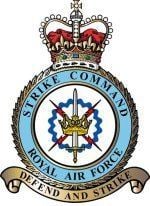Motto Defend and Strike Founded 30 April 1968 | ||
 | ||
Active 30 April 1968–1 April 2007 Similar Royal Air Force, RAF Air Command, RAF Personnel and Train, Royal Air Force Germany, RAF Support Command | ||
The Royal Air Force's Strike Command was the military formation which controlled the majority of the United Kingdom's bomber and fighter aircraft from 1968 until 2007 when it merged with Personnel and Training Command to form the single Air Command. It latterly consisted of two formations - No. 1 Group RAF and No. 2 Group RAF. The last Commander-in-Chief was Air Chief Marshal Sir Joe French.
Contents
History
Strike Command was formed on 30 April 1968 by the merger of Bomber Command and Fighter Command, which became No. 1 Group and No. 11 Group respectively. Signals Command was absorbed on 1 January 1969, Coastal Command was absorbed on 28 November 1969 and Air Support Command (formerly Transport Command) was absorbed on 1 September 1972.
NATO Role
In 1975, the Command acquired a NATO title, Commander-in-Chief United Kingdom Air Forces - UKAIR. UKAIR was fell under NATO's Allied Command Europe in Mons in Belgium. In case of war with the Warsaw Pact the command would have commanded all Royal Air Force units in the United Kingdom as well as the US Air Force's Third Air Force based at RAF Mildenhall with its subordinate wings and squadrons. Reinforcements coming from the continental United States, as well as units transitioning to other European fronts, would have also come under UKAIR.
Post Cold War
RAF Germany was absorbed as No. 2 (Bomber) Group on 1 April 1993. The RAF's Process and Organisation Review concluded that Strike Command and Personnel and Training Command should be co-located at a single command headquarters: it was subsequently decided that both commands should be located at High Wycombe and in 2007 Strike Command and Personnel and Training Command were merged into a single command - Air Command.
Structure
Headquarters Strike Command (often abbreviated to HQSTC) was located at RAF High Wycombe in Buckinghamshire. The Command was divided into a number of Groups, which at first reflected the function of the old Fighter, Bomber and Coastal Command. Subsequent reorganisations changed things greatly and before the final reorganization, the two Groups which made up Strike Command were:
Component groups of Strike Command included:
Air Officer Commanding-in-Chief
Air Officers Commanding-in-Chief included:
